Motohide Tamura, Professor, Department of Astronomy
Is the Earth, Jupiter, and other planets commonplace in the universe? Is the solar system special?
The observation that first demonstrated the existence of planets on stars other than the Sun was the subject of the 2019 Nobel Prize in Physics.
The discovery triggered a variety of observations of planets beyond our solar system, but direct observations of distant planets themselves have been difficult and discoveries have been limited, with most of the detections being indirect.
In order to capture images of the second Earth with the next generation of Very Large Telescopes, technology is being developed to almost completely remove the effects of the Earth's atmosphere, as if a ground-based telescope were launched into space.
The Subaru, Japan's largest telescope with an 8-meter aperture, is equipped with super-compensating optics that take advantage of this technology, and a new exoplanet has been directly discovered.
Furthermore, by taking into account the stellar wobble caused by the planet's gravity, the efficiency of planet detection by direct observation has been improved, and the planet's mass has been determined more precisely than ever before.
![]()
More than 5,000 exoplanets have been discovered so far. However, most of them were discovered by indirect observation. In other words, we do not directly observe the light from the planet as if it were a photograph, but only look at the stars that are affected by the planet.
Although direct imaging of some exoplanets was successful around 2010, the number of such discoveries has not increased much even in recent years. This is mainly due to the following two reasons: (1) the atmospheric fluctuations of the Earth need to be corrected to the utmost limit in order to suppress the influence of bright stellar light, and (2) there is no good method for narrowing down a promising observation target that has a planet, so a blind search method has been used by observing a large number of celestial objects.
Therefore, in this study, unlike the conventional search method, data from the Gaia and Hipparcos satellites, which can precisely measure the positions of stars on the celestial sphere (astrometry), are used to obtain indirect evidence that suggests the existence of planets that cause stellar wobbliness on the celestial sphere, and to determine the effects of such wobbliness on the existence of planets. We then directly imaged only the promising objects that showed the effects of the indirect evidence.
In this study, our international research team successfully discovered a new exoplanet, HIP 99770b, using a combination of SCExAO and astrometry (Figure). SCExAO has about 10 times more elements than conventional adaptive optics systems, and can produce sharp images of stars as if the Subaru Telescope had been launched into space. SCExAO has about 10 times more elements than conventional adaptive optics, and can produce sharp images of stars as if the Subaru Telescope had been launched into space.
This is the first planet discovered by direct imaging in conjunction with astrometry. It orbits HIP 99770 A, a star about twice as massive as the Sun, 17 times farther away than the Sun-Earth distance. The orbit is slightly elliptical in shape.
The mass of the planet was precisely determined to be about 15 times the mass of Jupiter. In ordinary direct imaging observations, planetary masses are estimated by comparing the brightness of the planet measured on the image with a model, which is subject to large errors. In the present study, the masses were precisely determined with an error of only about one Jupiter mass, based on both the dynamical mass, which was obtained by taking into account the data from the indirect method of stellar wobble, and the mass based on the brightness from the direct imaging.
There are many other stars for which astrometric data indicate the presence of planets, and future direct imaging discoveries of new exoplanets are likely to follow by expanding the present method. We expect that future observations using next-generation telescopes with apertures in the 30-meter class, such as the TMT (Thirty Meter Telescope) and adaptive optics, will image a "second Earth" using the same technique.
The results were published in T. Currie, et al, Science, 380, 198 (2023).
(Press release, April 14, 2023)
Frontiers of Science for Undergraduates



